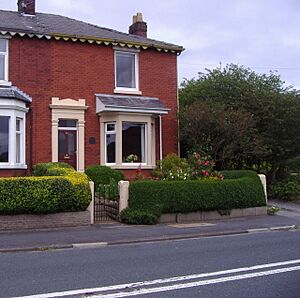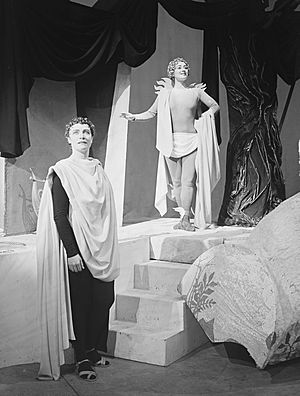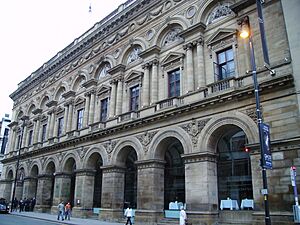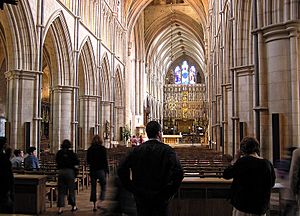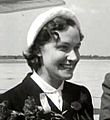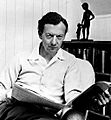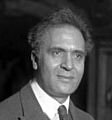Kathleen Ferrier facts for kids
Quick facts for kids
Kathleen Ferrier
|
|
|---|---|

Ferrier in 1951
|
|
| Born | 22 April 1912 Higher Walton, Lancashire, England
|
| Died | 8 October 1953 (aged 41) London, England
|
| Occupation | Contralto singer |
| Spouse(s) |
Albert Wilson
(m. 1935; div. 1947) |
Kathleen Mary Ferrier (22 April 1912 – 8 October 1953) was a famous English singer. She was a contralto, which means she had a deep female singing voice. Kathleen became well-known around the world. She sang on stage, in concerts, and made many recordings. Her songs ranged from folk tunes to classical music by famous composers like Bach and Mahler.
Kathleen's death from cancer, when she was very famous, surprised many people. The public did not know she was so ill until after she passed away.
She was the daughter of a schoolmaster in Lancashire. Kathleen showed talent as a pianist from a young age. She won many amateur piano contests while working as a telephone operator. She did not start singing seriously until 1937. After winning a singing competition, she began to get offers to sing professionally. She took singing lessons to improve her voice.
During World War II, Kathleen sang at concerts across the UK. Her career grew in 1942 when she met conductor Malcolm Sargent. He helped her get an agent, and she became a regular performer in London. She also made many radio broadcasts for the BBC.
In 1946, Kathleen sang on stage for the first time at the Glyndebourne Festival. A year later, she became famous for her role as Orfeo in Gluck's opera Orfeo ed Euridice. These were the only two opera roles she ever performed. As her fame grew, she worked closely with important musicians like Benjamin Britten, Sir John Barbirolli, and Bruno Walter. She became known internationally through her tours to the United States and Europe.
Kathleen was diagnosed with breast cancer in March 1951. Even while getting treatment, she continued to perform and record. Her last public show was as Orfeo in February 1953, eight months before she died. Many memorials were created in her honor. The Kathleen Ferrier Cancer Research Fund started in May 1954. The Kathleen Ferrier Scholarship Fund gives awards to young singers every year.
Contents
Early Life and Music Beginnings
Childhood and Piano Talent
Kathleen Ferrier was born on April 22, 1912. Her family lived in the village of Higher Walton in Lancashire, England. Her father, William Ferrier, was the head of the village school. He loved music and sang in choirs. Her mother, Alice, was also a good singer with a strong contralto voice.
Kathleen was the youngest of three children. When she was two, her family moved to Blackburn. From a young age, Kathleen showed great skill at playing the piano. She took lessons and quickly became very good. In 1924 and 1925, she won high places in piano competitions.
Working and Playing Music
Because her father was going to retire, Kathleen could not afford to go to a music college. In 1926, she left school and started working. She became a trainee at the telephone exchange in Blackburn. She kept studying piano and won a national contest for young pianists in 1928. Her prize was a new piano.
In 1929, she played piano at a concert in Blackburn. She also made her first radio broadcast in 1930, playing music by Brahms. Around this time, she became a full telephone operator.
In 1931, Kathleen passed important music exams. She also started taking singing lessons. She sang a small part in a church performance of an oratorio. However, her voice was not considered special yet. Her main focus was still the piano. In 1935, she married Albert Wilson. At that time, married women could not work at the telephone exchange, so she left her job. Her marriage ended in 1947, but they remained friends.
Becoming a Singer
First Singing Successes
In 1937, Kathleen entered a piano competition at the Carlisle Festival. She also decided to enter the singing contest for fun. She easily won the piano trophy. In the singing finals, she won the top vocal award. To celebrate her double win, she received a special rose bowl.
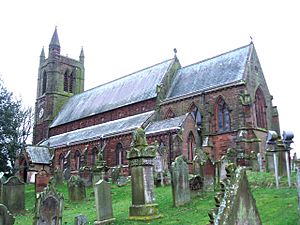
After her wins, Kathleen started getting offers to sing. Her first professional singing job was in autumn 1937. She sang at a harvest festival in a village church and was paid one guinea. She won another gold cup at a festival in 1938. A BBC radio producer heard her sing and invited her to perform on his show. This was her first radio broadcast as a singer in 1939. It brought her more radio work.
At the 1939 Carlisle Festival, Kathleen impressed a music teacher named J. E. Hutchinson. She became his student and began to learn more classical songs.
Moving to London and Gaining Fame
When her husband joined the army in 1940, Kathleen started using her maiden name, Ferrier, again. In December 1940, she sang professionally as 'Kathleen Ferrier' for the first time. She performed in Handel's Messiah. In 1941, she joined an organization that provided concerts for soldiers and workers. Here, she worked with famous artists.
She met conductor Malcolm Sargent who recommended her to a London concert agency. John Tillett, the agent, quickly accepted her. On Sargent's advice, Kathleen decided to move to London. In December 1942, she moved into a flat in Hampstead with her sister.
Becoming a Star
Growing Recognition
Kathleen gave her first London concert on December 28, 1942. She sang at the National Gallery. She felt she needed more voice training. She asked the famous singer Roy Henderson to teach her. Henderson became her regular voice coach for the rest of her life. He said her voice was warm and rich. He also noted her hard work and dedication.
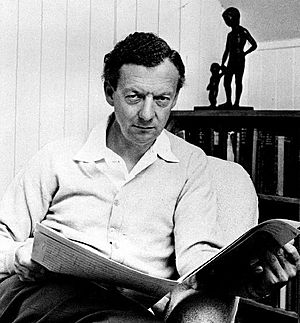
In May 1943, Kathleen sang in Handel's Messiah at Westminster Abbey. Critics noticed her beautiful singing. This led to more important concerts and radio work. She became nationally recognized through her frequent appearances on popular radio shows. In 1944, she made her first published record. She later moved to Decca to record more music.
Kathleen continued to travel and perform during the war. In November 1944, she sang in Elgar's The Dream of Gerontius, which became one of her most famous roles. In December, she met conductor John Barbirolli, who became a close friend. In September 1945, she made her debut at the London Proms.
Kathleen usually avoided opera, but composer Benjamin Britten asked her to sing in his new opera. It was called Lucretia and opened the first postwar Glyndebourne Festival in 1946. She enjoyed the rehearsals and her role.
Her performances at Glyndebourne received good reviews. She also traveled abroad for the first time to Amsterdam, where audiences loved her. In 1947, she returned to Glyndebourne to sing Orfeo in Gluck's opera Orfeo ed Euridice. She had often sung Orfeo's famous song, "What is life," in concerts. Her performance as Orfeo was highly praised by critics.
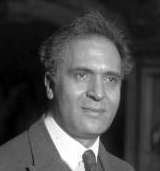
Kathleen's success at Glyndebourne led to her meeting conductor Bruno Walter. He asked her to sing in Mahler's Das Lied von der Erde at the 1947 Edinburgh International Festival. Walter was impressed by her audition. He later wrote that she was "one of the greatest singers of our time." Their partnership became very special.
Peak of Her Career (1948–1951)
In January 1948, Kathleen went on her first tour to North America. In New York, she sang Das Lied von der Erde with Bruno Walter. She also gave concerts in Ottawa and Chicago.
During 1948, Kathleen had many performances. She sang at the Proms and the Edinburgh Festival. She also performed Mahler's Kindertotenlieder with Barbirolli. She returned to the Netherlands in January 1949 for more concerts. Then, she began her second American tour. She sang in a concert version of Orfeo ed Euridice in New York, which critics loved.
On this tour, she met Canadian pianist John Newmark. They formed a strong working relationship. Soon after returning to Britain, Kathleen went to Amsterdam. In July 1949, she sang in the world premiere of Britten's Spring Symphony, which he wrote especially for her. At the Edinburgh Festival, she gave two concerts with Bruno Walter playing the piano.
The next 18 months were very busy. She visited Europe many times and had a third American tour. This tour included performances of Orfeo ed Euridice in San Francisco. There, she met the famous American singer Marian Anderson, who admired Kathleen's voice. Kathleen's busy schedule continued with concerts in Amsterdam, London, and Edinburgh. She also toured Austria, Switzerland, and Italy. In Vienna, she recorded Bach's Mass in B minor.
In early 1951, while touring in Rome, Kathleen learned her father had died. She was sad but continued her tour. She returned to London and rehearsed a new work with Barbirolli. Two weeks later, she found a lump on her breast. She still performed in Germany and the Netherlands before seeing her doctor. She was diagnosed with breast cancer and had surgery in April. All her immediate concerts were canceled.
Later Career and Final Years
Health Challenges
Kathleen started performing again in June 1951. She sang in the Mass in B minor. She also visited the Holland Festival, where she sang Orfeo four times. Throughout the summer, her concerts were mixed with hospital visits. She was well enough to sing at the Edinburgh Festival in September. In November, she sang Land of Hope and Glory at the reopening of Manchester's Free Trade Hall. Barbirolli said it moved everyone to tears. After this, Kathleen rested for two months for radiation treatment.
In January 1952, Kathleen joined Britten and Pears for concerts. Britten later called this tour "perhaps the loveliest of all" their work together. Despite her health problems, she continued to sing in major works. She performed for Queen Elizabeth II and Princess Margaret at a private party. Her health got worse, but she refused some treatments that might harm her voice. In May, she traveled to Vienna to record Das Lied and Mahler's Rückert-Lieder with Bruno Walter. She finished the recordings despite much pain.
In 1952, Kathleen attended her seventh Edinburgh Festival. She also did several studio recordings. In November, a critic wrote that her performance had "distracting extra vocal appeals." Kathleen accepted the comments gracefully. In December, she sang in the BBC's Christmas Messiah, her last time performing this work. On New Year's Day 1953, she was honored with the Commander of the Order of the British Empire (CBE) award.
Last Performances and Death
In early 1953, Kathleen was rehearsing for Orpheus, an English version of Orfeo ed Euridice. It was to be performed at the Royal Opera House in February. Her only other event in January was a BBC recording. She also discussed surgery with doctors but decided against it.
The first Orpheus performance on February 3 was a great success. Kathleen was pleased with the good reviews. However, she was weak from her treatments. During the second performance, her left leg bone partly broke. Other cast members quickly supported her, and the audience did not notice. Kathleen finished her songs and took her bows before going to the hospital. This was her last public appearance. The remaining shows were canceled. The public was told she had a strain from arthritis.
Kathleen spent two months in the hospital. She missed her CBE award ceremony, but the ribbon was brought to her. She moved to a new ground-floor apartment because she could no longer use stairs. But after only seven weeks, she had to return to the hospital. Her condition continued to worsen despite more operations. In June, she learned she had won the Gold Medal of the Royal Philharmonic Society. She was the first female singer to receive this honor since 1914. She wrote that this news made her feel much better.
Kathleen became weaker and saw only her sister and a few close friends. She died at University College Hospital on October 8, 1953, at age 41. She was cremated a few days later.
Her Impact and Legacy
The news of Kathleen's death shocked the public. Many people did not know how ill she was. One critic said that "no singer in this country has ever been more deeply loved." Her death saddened many people in Britain. The editor of Granta magazine believed she was "the most celebrated woman in Britain after the Queen."
Her colleague Bruno Walter said, "The greatest thing in music in my life has been to have known Kathleen Ferrier and Gustav Mahler—in that order." This shows how highly he thought of her. At her memorial service, a bishop said her voice "seemed to bring into this world a radiance from another world."
People often wonder what Kathleen's career would have been like if she had lived. She had been offered roles in famous operas. Some believe her style might be less popular today. But she was a singer for her time. Her art was "upright, austere, unfussy, fundamental and sincere."
Soon after her death, a fund was started in her name to support cancer research. Donations came from all over the world. A special concert was held to raise money. The Kathleen Ferrier Cancer Research Fund helped create a special chair for cancer research at University College Hospital. It still funds research today.
Another fund, the Kathleen Ferrier Memorial Scholarship Fund, was created to help young British singers. Since 1956, this fund has given annual awards. Many famous singers have won these awards. The Kathleen Ferrier Society was founded in 1993 to promote interest in her life and work. In 2012, the Society held events to celebrate 100 years since her birth. Also in 2012, she was honored on a special set of stamps by the Royal Mail.
A documentary film about Kathleen Ferrier was made in 2012. It included interviews with her family and friends. A street in Basildon, Essex, is named Kathleen Ferrier Crescent in her honor.
Recordings
Kathleen Ferrier made many studio recordings. She also had live performances recorded that were later released. Many of her recordings have been re-released over the years. Between 1992 and 1996, Decca Records released a special collection of her music on 10 CDs.
She performed many songs that were never fully recorded. For example, only one song from Elgar's Dream of Gerontius was recorded. Also, most of her 20th-century songs were not recorded.
Her recording of the folk song "Blow the Wind Southerly" is very famous. It has been played on the radio many times. Another well-known song she recorded is "What is Life?" from Orfeo ed Euridice. Her records sold very well, competing with other stars of her time. Even today, Kathleen Ferrier's recordings still sell hundreds of thousands of copies each year.
Images for kids
See also
 In Spanish: Kathleen Ferrier para niños
In Spanish: Kathleen Ferrier para niños


